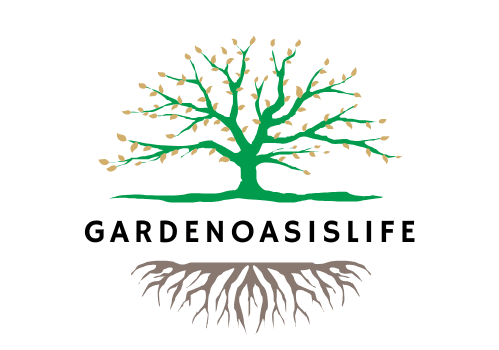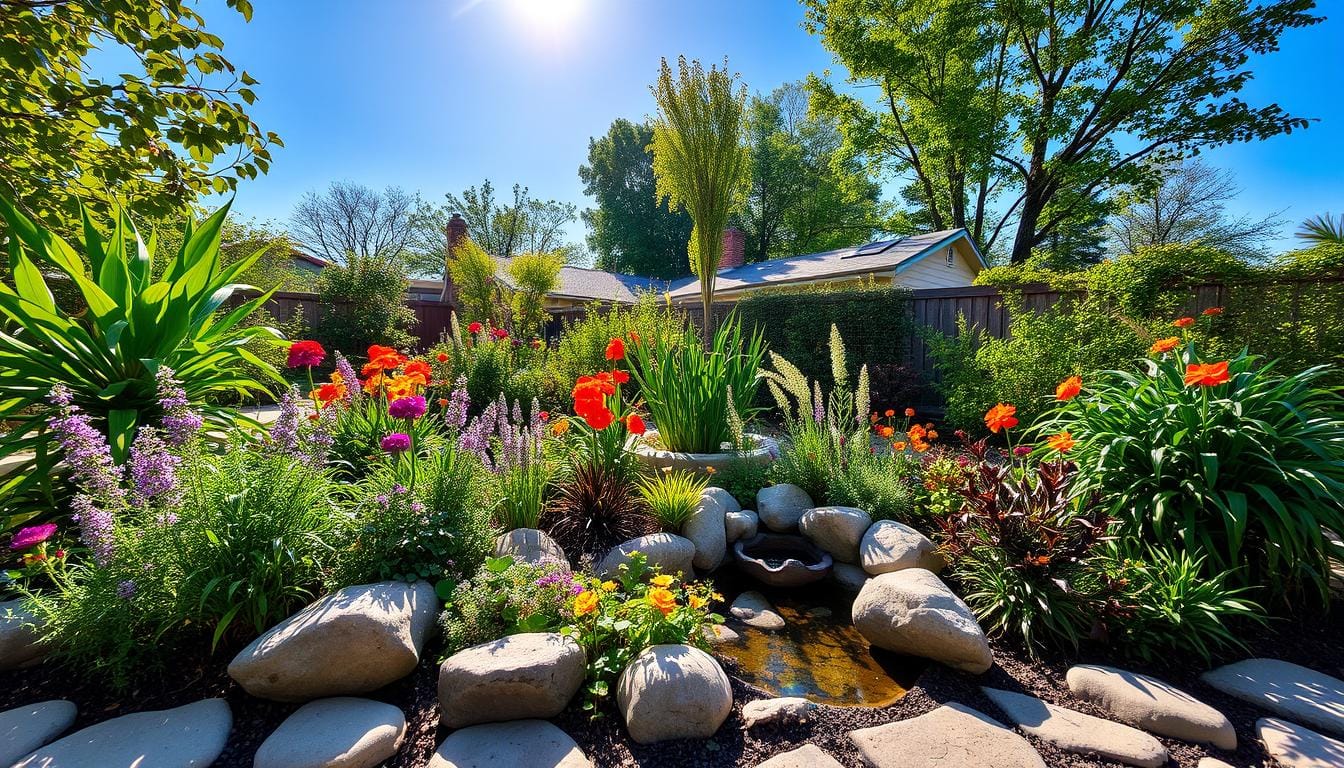Create a Beautiful Rain Gardens for Your Backyard
Imagine turning your backyard into a lush, eco-friendly oasis. It not only makes your outdoor spaces more beautiful but also helps manage stormwater sustainably. Rain gardens are a nature-based solution that’s becoming popular. They let you create a stunning garden that also helps reduce pollution, saves water, and supports local wildlife.
Rain gardens are shallow depressions in the landscape. They collect and hold rainwater runoff from hard surfaces like roofs and driveways. As the water slowly soaks into the ground, it cleans and filters the water. This natural method not only helps the environment but also makes your backyard more beautiful, creating a stunning focal point.
Key Takeaways
- Rain gardens are eco-friendly landscape features that help manage stormwater runoff and support local ecosystems.
- They can enhance the beauty of your backyard while also reducing pollution and conserving water.
- Incorporating a rain garden into your landscape can provide a sustainable and visually appealing solution for your outdoor living space.
- Rain gardens help filter and clean rainwater, reducing the amount of pollutants that enter nearby waterways.
- They create habitats for local wildlife, promoting biodiversity and a healthier environment.
Understanding Rain Gardens and Their Environmental Impact
Rain gardens are a smart way to manage stormwater. They use natural processes to lessen the harm from urban areas and land changes. These shallow spots soak up and clean water from hard surfaces like roofs and sidewalks. They help keep our environment healthy through Low Impact Development.
Benefits of Natural Stormwater Management
Rain gardens do more than look good. They lower flood risks by slowing down water flow. This lets water soak into the ground, easing the load on old drainage systems. They also clean pollutants like heavy metals and oil, making water better for all living things.
How Rain Gardens Support Local Ecosystems
- Increased Biodiversity: Rain gardens are home to many plants and animals, offering food and shelter.
- Groundwater Recharge: They help refill underground water, keeping our water supply strong.
- Reduced Erosion: By slowing water, rain gardens prevent soil from washing away.
Rain gardens are key to managing water and protecting our ecosystems. They follow the ideas of Stormwater Management, Low Impact Development, and Environmental Stewardship. Using them can make our communities more sustainable and resilient over time.
“Rain gardens are not just a beautiful addition to our landscapes; they are a crucial component of our environmental infrastructure, helping to safeguard the health and vitality of our local ecosystems.”
Planning Your Rain Garden Location and Size
Creating a successful Bioretention feature in your backyard starts with the right location and size. These factors are key to effective Sustainable Landscaping and Water Conservation.
First, look at your property’s drainage and slopes. Place your rain garden where water naturally gathers or flows. This could be a low spot or near a downspout. But, keep it away from buildings and trees to avoid damage.
The garden’s size depends on the catchment area – the surface that drains into it. A good rule is to make the garden 5-7% of the catchment area. This helps capture the first inch of rainfall.
| Catchment Area (sq ft) | Recommended Rain Garden Size (sq ft) |
|---|---|
| 1,000 | 50-70 |
| 2,500 | 125-175 |
| 5,000 | 250-350 |
Choosing the right spot and size for your rain garden makes it very effective. It boosts your Bioretention efforts, supports Sustainable Landscaping, and saves water.
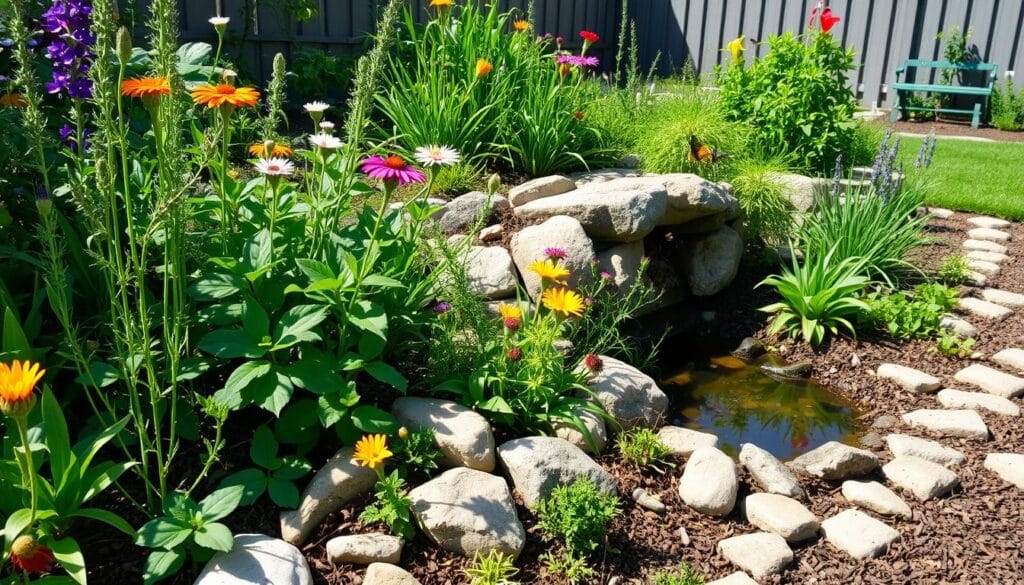
Essential Site Preparation and Soil Requirements
Creating a rain garden starts with site prep and soil knowledge. This step is key for a Permeable Surfaces and Green Infrastructure that handles stormwater well. It also supports local Bioretention.
Soil Testing and Amendment Guidelines
First, do a soil test to know your garden’s soil. This tells you what nutrients it has and how it drains. This info helps you add the right stuff to make your plants happy.
- Find out the soil type and how fast it drains.
- Check the pH and adjust it with compost or lime if needed.
- Add organic matter to help hold water and nutrients.
Proper Drainage Considerations
Good drainage is key for a rain garden’s success. Make sure the site slopes gently and the soil absorbs water well. This stops water from pooling or staying too long.
- Look at the drainage and fix any problems that could harm your garden.
- Use gravel or Permeable Surfaces to help water soak in and prevent soil compaction.
- Think about adding a drainage system like a perforated pipe to move extra water away.
Calculating Proper Depth and Shape
The depth and shape of your rain garden are very important. They help it catch and filter stormwater. Think about these carefully to make your garden work well.
By following these steps, you can make a rain garden that manages stormwater, helps local ecosystems, and looks great.
Selecting Native Plants for Your Rain Garden
Starting a beautiful rain garden means picking the right native plants. These plants are tough and fit well in your area’s weather and soil. They also help with Low Impact Development and Environmental Stewardship.
Think about how much water your plants need, how much sun they get, and how big they’ll grow. Native plants handle rain garden moisture levels well. They look great and bring in pollinators, helping your local ecosystems.
| Native Plant | Moisture Tolerance | Sun Exposure | Mature Size |
|---|---|---|---|
| Swamp Milkweed (Asclepias incarnata) | High | Full Sun | 2-4 feet tall |
| Cardinal Flower (Lobelia cardinalis) | High | Partial Shade | 2-4 feet tall |
| Blue Flag Iris (Iris versicolor) | High | Full Sun to Partial Shade | 2-3 feet tall |
Choosing a mix of native plants that love your local weather and soil makes a stunning rain garden. It’s not just pretty; it also helps the environment and supports local life.
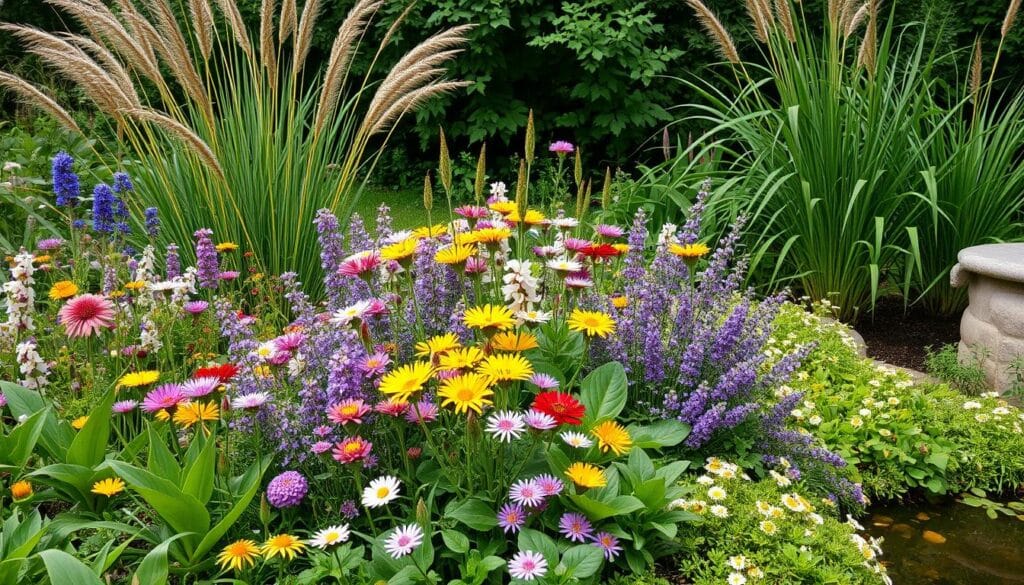
“Native plants are the foundation of a healthy, sustainable landscape that supports local wildlife and enhances the beauty of your outdoor living space.”
Design Principles for Attractive Rain Gardens
Creating a beautiful rain garden starts with smart design. Use layers of plants, add seasonal interest, and mix colors and textures. This way, you get a lush, green space that looks great and helps the environment.
Layer Planning for Visual Appeal
Begin with the height of your plants. Mix tall perennials, medium plants, and low groundcovers. Place the tallest plants at the back and the shortest in the front. This creates a layered look that’s eye-catching.
Seasonal Interest Considerations
Your rain garden should look good all year. Choose native plants that bloom at different times. This keeps your garden colorful and supports Sustainable Landscaping and Green Infrastructure.
Color and Texture Combinations
Play with colors and textures to make your garden pop. Match plants with colors that look good together, like blues and yellows. Mix different types of leaves for depth and interest.
Following these design tips, you can make your rain garden a beautiful Water Conservation spot. It will be both stunning and eco-friendly.
Installation Steps and Best Practices
Setting up a Stormwater Management system with a Low Impact Development method, like a Bioretention rain garden, needs careful planning. Follow these steps to make sure your rain garden works well. It will filter runoff and help recharge groundwater.
- Site Preparation: Start by digging out the area for the rain garden. Remove any plants or debris. Check the soil’s drainage and adjust the depth if needed.
- Soil Amendments: Add compost to the soil to hold water and nutrients better. This helps your plants grow well in the rain garden.
- Plant Selection and Placement: Pick a mix of native, drought-resistant plants. Arrange them in a way that looks good, thinking about height, color, and when they bloom.
- Mulching: Spread 2-4 inches of organic mulch, like shredded bark, on the surface. It keeps moisture in, stops weeds, and prevents soil loss.
- Inlet and Overflow Management: Make sure water flows into the garden and out when it rains too hard. This keeps the garden working right.
By sticking to these Stormwater Management tips, your Low Impact Development rain garden will flourish. It will be a green, helpful part of your yard.
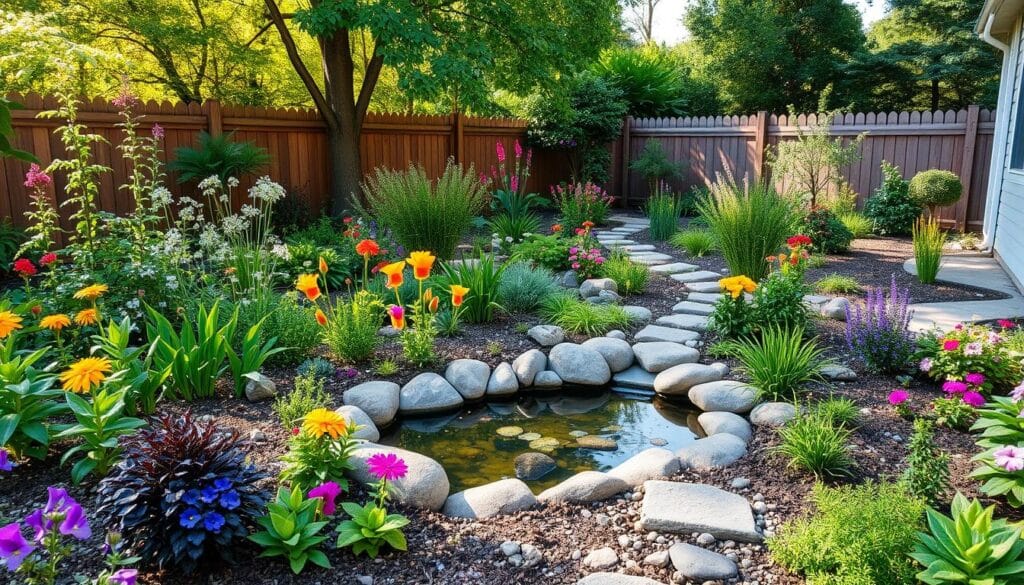
“A well-designed and maintained rain garden can effectively filter out up to 90% of nutrients and sediments from stormwater runoff, making it a valuable asset for any property.”
| Installation Step | Best Practice |
|---|---|
| Site Preparation | Ensure proper drainage and remove existing vegetation or debris |
| Soil Amendments | Incorporate organic matter to improve soil quality |
| Plant Selection | Choose diverse, native, and drought-tolerant species |
| Mulching | Apply 2-4 inches of organic mulch to the surface |
| Inlet and Overflow | Integrate proper drainage mechanisms |
Maintenance Tips for Long-lasting Rain Gardens
To keep your rain garden thriving, you need a consistent care plan. A seasonal maintenance schedule and quick action on common problems will help. This way, your Sustainable Landscaping feature will stay beautiful and useful for many years.
Seasonal Maintenance Schedule
Year-round care is crucial for your rain garden’s success. Here’s a simple plan to keep it healthy:
- Spring: Remove dead plants, divide perennials, and add new Native Plants.
- Summer: Watch for weeds, water when dry, and prune plants to keep them in shape.
- Fall: Clean up leaves, divide plants, and mulch to protect the soil.
- Winter: Check for erosion or damage and fix it to prepare for spring.
Common Problems and Solutions
Rain gardens are mostly easy to care for, but you might face some issues. Here are solutions to keep your garden in top shape:
- Erosion: Use rock or gravel to slow water and prevent soil loss.
- Plant die-off: Find out if it’s from too much or too little water and adjust your care.
- Excessive weed growth: Pull weeds by hand and mulch to stop weeds.
Weed Management Strategies
Keeping a balance of Native Plants and controlling weeds is key for your rain garden’s health. Try these strategies:
- Hand-pull weeds regularly, making sure to get the whole root.
- Use a thick layer of organic mulch to stop weeds.
- Use a targeted herbicide for tough weeds, but only as a last resort.
By following these tips, your rain garden will stay a stunning and eco-friendly part of your Sustainable Landscaping for years.
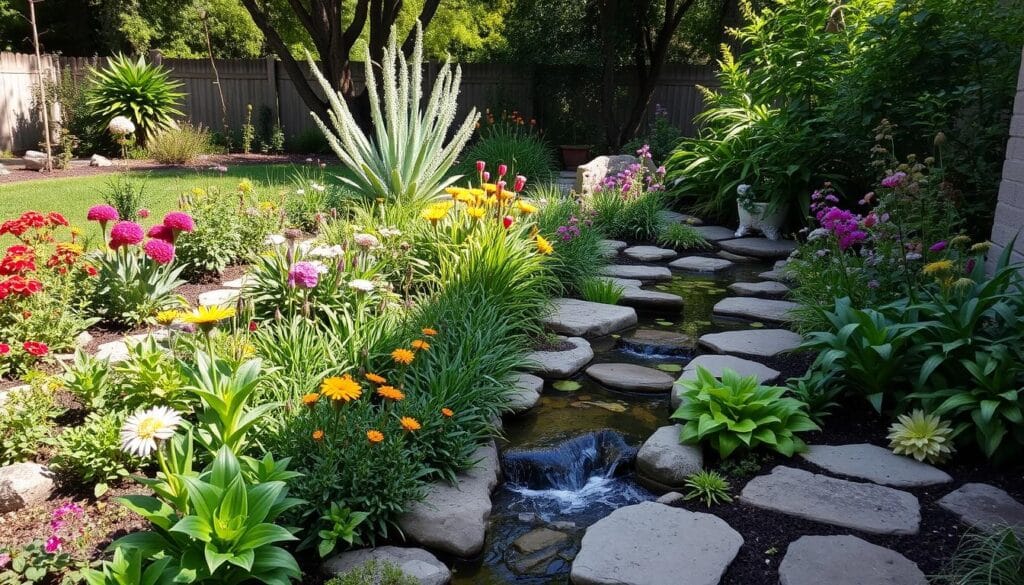
Integrating Rain Gardens with Existing Landscape Features
Adding Green Infrastructure like rain gardens to your landscape can be beautiful and smart. It blends well with other features, making your outdoor space look good and work better for Water Conservation.
Place the rain garden as a key spot or a link between landscape areas. For instance, put it by a walkway or patio. This makes it a natural part of your design, not just a separate piece.
Use Permeable Surfaces to connect the rain garden to other parts of your landscape. Paths made of permeable pavers or decomposed granite help water flow into the rain garden. This also ties your landscape together visually.
Adding native plants and natural elements like boulders or driftwood helps tie the rain garden to the rest of your garden. This creates a balanced and harmonious look in your outdoor space.
| Landscape Feature | Integration Strategies |
|---|---|
| Patios and Walkways | Position rain garden as a transitional element, connect with permeable surfaces |
| Existing Flower Beds | Utilize complementary plant species and design elements |
| Shaded Areas | Select shade-tolerant rain garden plants to maintain cohesion |
By carefully blending your rain garden with your landscape, you can make a beautiful and functional outdoor space. It will enhance your property’s beauty and usefulness.

Conclusion
Rain gardens are a great way to make your yard better and help the environment. They are good for both your home and the local wildlife. By adding a rain garden, you can help keep water clean and support local plants and animals.
Rain gardens do more than just look good. They also help keep nearby waterways healthy. These gardens are homes for many animals and plants, making your yard a better place for nature.
Now is the time to think about adding a rain garden to your yard. With the right plants and planning, you can create a beautiful, green space. It’s a chance to help the environment and make your yard more valuable over time.
